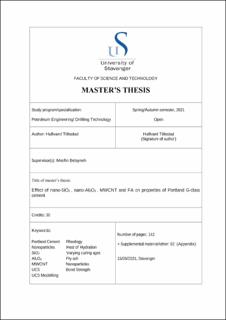| dc.description.abstract | Cement is an important element in oil and gas wells, as it provides structural integrity and acts a barrier to prevent unwanted leakages in the well. According to NORSOK D-010 standard, properties of cement are required to be impermeable, ductile, resistant to corrosive substances and non-shrinking [1]. However, a well integrity survey in the North Sea Continental Shelf (NCS) conducted by PSA (2006) showed that 10.67% of reported well integrity issues were associated with cement related failures [2]. Furthermore, a survey in Alberta, found that approximately 14490 wells suffered from gas migration issues originating from poor cement jobs [3]. In fact, a survey conducted in 2001, found that primary cements jobs had a failure rate of roughly 15% [4]. Additionally, in 2010, a survey found that 20% of detected well integrity issues were due to poor zonal isolation and annular integrity, likely as a result of cement failures [5]. These surveys show that cement as a barrier material does not maintain lifelong well integrity, which does not satisfy the regulatory requirements.
Nanotechnology (1-100nm) is a growing technology that seeks to introduce novel and superior properties which could create innovative solutions for conventional technologies and engineering problems across several fields of studies. The application of nanotechnology in the petroleum industry has also shown promising results. Therefore, in this thesis, the impact of nanoparticles and fly ash on neat G-class cement has been investigated. A total of five different experimental designs were formulated, which were cured for 3, 7 and 28 days. Nanoparticles and FA as additives exhibited predominantly favourable results in several of the tested properties of neat G-class cement. SiO2 nanoparticles exhibited high early strength with 23,27% and 26,95% UCS improvement after 3 and 7 days. A binary blend of Al2O3 and SiO2 nanoparticles yielded 26,64% UCS increase after 28 days. Small concentrations of FA gave a 21,24% UCS improvement after 28 days of curing. A ternary blend of nanoparticles and fly ash mixed with SiO2 also provided improved properties of neat G-class cement after 28 days of curing. The empirical uniaxial compressive strength (UCS) vs compressional wave velocity (Vp) model developed from measured data in this thesis, has shown quite good predictions of UCS. | |
